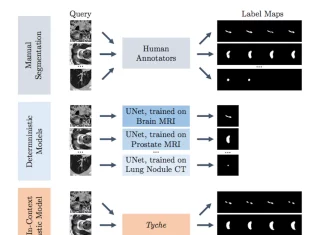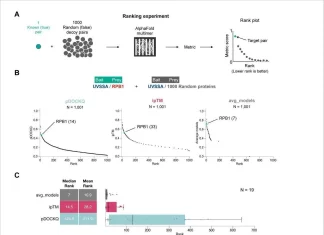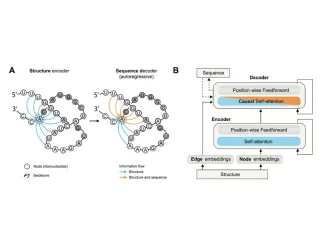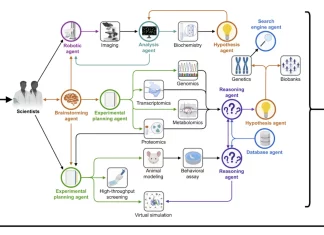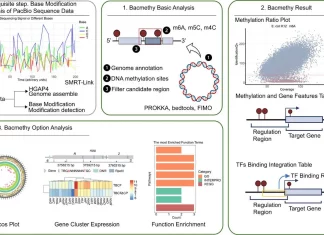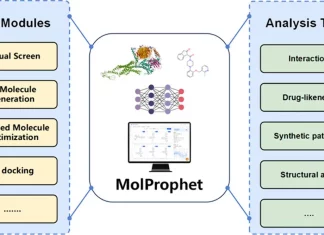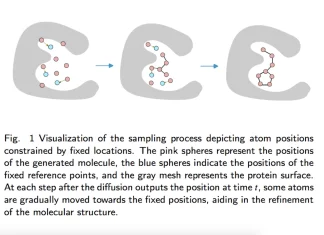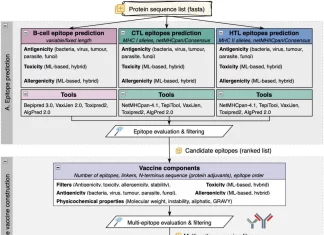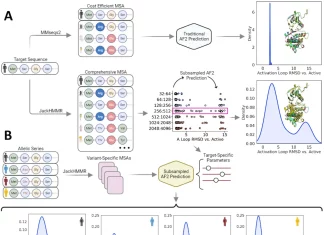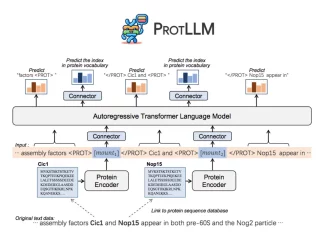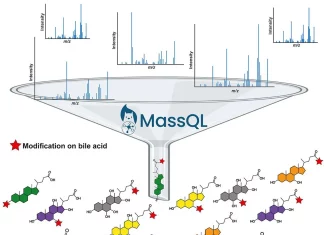GEMS: DeepMind’s Novel Approach to Accurate Biomolecular Dynamics through Machine-Learned Quantum-Mechanical...
Think about peering into the intricate world of biomolecules, those complex assemblies that direct the symphony of life. Scientists have long relied on molecular...
Deciphering the Genetic Blueprint: Groundbreaking Research Reveals Genomic Factors Driving Monkeypox...
An epidemic of monkeypox occurred in May 2023 that led to a disease named mpox displaying symptoms such as fever, enlarged lymph nodes, and...
Unveiling Bioinformatics Copilot 1.0: A Cutting-Edge LLM-Driven Solution for Transcriptomic Data Analysis
Single-cell transcriptomics has been generating large-scale information, improving our knowledge of cellular processes across different tissues, and facilitating medication discovery, diagnosis, and prognosis. But...
Decoding Proteins with DeProt: A Breakthrough in Language Modeling through Quantized...
Conventional representational models of protein functions have demonstrated notable performance in downstream tasks; nevertheless, they frequently do not incorporate explicit information on protein structure,...
Empowering Clinicians: How ‘Tyche’ Revolutionizes Medical Image Analysis with AI to...
Just think about yourself as a physician examining an x-ray. You see an area that seems out of the ordinary, but you are unsure...
Unlocking Protein Co-regulation: How Genomic Language Models Illuminate Function Predictions
Are you aware of the perception of a genomic language model? If not, then it's worth mentioning that researchers at Harvard, Cornell University, and...
A New Era in Interactomics: Exploring Predictomes, the AlphaFold-Modeled Protein Interaction...
Imagine a teeming city where proteins are the movers and shakers. Each protein intertwines with others in partnerships that are vital to every cellular...
Revolutionizing Molecular Linker Design with DiffLinker: The Power of Equivariant 3D-conditional Diffusion...
The effective paradigm of molecular linkers in drug discovery is crucial for obtaining relevant candidate molecules in early-stage drug development. In this study, researchers...
Unleash the Power of PPI3D: A Comprehensive Web Server to Explore,...
Understanding molecular mechanisms requires an understanding of protein interactions with nucleic acids. Researchers can query preprocessed and clustered structural data, analyze the data, and...
Untangling the Cellular Family Tree: GEMLI Estimates Lineage from scRNA-seq Data
Researchers from the Institute of Bioengineering, Lausanne, Switzerland, introduce GEMLI, a powerful computational tool that enables robust identification of cell lineages solely from scRNA-seq...
Smart Sampling for Smarter Drugs: How Active Learning Boosts Drug Discovery
In computational drug discovery, active learning (AL) is a potent approach that makes it possible to identify the best binders from large chemical libraries....
UC Berkeley’s Breakthrough RNA Language Models Predict Mutations that Enhance RNA...
A new tool from UC Berkeley can predict mutations that can improve the way how RNA works. By leveraging hyperthermophilic RNAs, the researchers identified...
Supercharge Epigenomic Workflows with EAP: A Cloud-Based Platform for Comprehensive and Interactive Analysis...
The significance of comprehending gene expression regulation in tissue development is highlighted by the examination of disease progression through methods such as ChIP-seq and...
Unlocking Cell Biology with AI: How Large Language Models Comprehend the Complexity...
Picture a world where computers can not only translate languages but also decipher biology’s convoluted language. This is the exciting frontier of Large Language...
Unveiling VarChat: A Leap Forward in Genomic Variation Interpretation
Research on genomes is booming in the scientific community, and this is translating into an explosion of published results. Genetic experts and researchers now...
Can AI Agents Become the Next Big Breakthrough in Biomedical Research?
Imagine a world where scientific breakthroughs are not just solitary genius work but a collaboration between humans and a new breed of partners- AI...
Breakthrough in Protein Design: MIT Researchers Develop Computational Approach for Easier...
Modeling the combinatorially huge number of sequences is not practical since previous approaches frequently restrict optimization to a narrow mutational radius, restricting the design...
Streamlining Bacterial Epigenomics: Bacmethy, One-Stop Tool for Bacterial DNA Methylation and...
DNA has been a holy grail as it is believed to contain all the intricate instructions that build and run an organism. However, scientists...
Meet MolProphet: A One-Stop AI Platform for the Early Stages of...
Are you aware that plenty of operational AI applications have emerged in the early stages of small-molecule drug discovery? Do you recognize that those...
Can AI Help Us Discover New Drugs Faster? Unveiling MegaKG, the...
Drug discovery has traditionally been a tedious and difficult process characterized by sifting through large amounts of data, which may be about to get...
Exploring BioMedLM – 2.7 Billion Parameter GPT-style Autoregressive Model: A Breakthrough...
A new NLP model called BioMedLM from the researchers of Stanford University and DataBricks seeks to rival models like Med-PaLM 2, which performs admirably...
Bridging Gaps in Structure-Based Drug Design: The MolSnapper’s Breakthrough Conditioning Diffusion...
The synergy among the Nuffield Department of Medicine and the Department of Statistics at the University of Oxford represents a blend of medical expertise...
Exploring Medicine’s Future with KnowDDI: How Knowledge Subgraph Learning Improves Drug-Drug...
Have you ever wondered what happens when you take multiple medications? Although each drug is intended to address a particular condition, there are instances...
A New Weapon in the Public Health Arsenal: VaccineDesigner Simplifies Epitope-based...
A ground-breaking solution in modern-day continuously advancing healthcare internationally is developing waves in vaccine improvement. Developed by brilliant minds at the School of Medicine,...
Meet PiMine: A Database-Driven Approach for Protein-Protein Interface Similarity Detection
Researchers at Universität Hamburg introduced PiMine, an application that senses structurally related protein-protein interfaces while being driven by a database. PiMine analyzes these interfaces,...
Brown University’s Subsampled AlphaFold2 Approach for Predicting Protein Dynamics: A Game-changer...
Proteins are life's molecular workhorses and play crucial roles in every biological process. Understandably, their complex shapes, also known as conformations, are the key...
Unlocking New Drug Targets: Researchers Develop Computational Method to Target Proteins Inside...
Can you imagine that you can design proteins that have a particular function, and they are like small robots working inside our cells? This...
Revolutionizing Cell Type Annotation: GPT-4’s Breakthrough in scRNA-seq Analysis
Single-cell RNA sequencing (scRNA-seq), a rapidly developing field of RNA sequencing of single cells, has recently made a breakthrough that could revolutionize cell type...
AI vs. Superbugs: A New Generative AI Model ‘SyntheMol’ Designs Powerful Antibiotics...
AI is being used to find novel antibiotics for bacteria resistant to pandemics; however, the currently used techniques have serious drawbacks. While generative models...
A New Era in Enzyme Design: How NeuroFold Integrates Multimodal Data...
The main obstacle in protein engineering is the lack of diversity in training data, which makes it difficult to create high-performance enzyme variations with...
Creating Antibodies from Scratch: Scientists Design Single-Domain Antibodies with Atomic Precision...
The inability to logically design new antibodies that bind a particular epitope on a target persists despite the crucial role that antibodies play in...
Unveiling MetagenomicKG: A Pioneering Knowledge Graph for Metagenomics Exploration
In the vast and intricate realm of metagenomics, where microbial communities unveil a wealth of biomedical knowledge, a groundbreaking development has emerged. Scientists from...
Deciphering Ligand-Receptor Signaling Dynamics at Cellular Resolution with CytoSignal: A Breakthrough...
A thorough understanding of the cellular connections inside these tissues is being made possible by technologies that use spatial transcriptomic approaches to revolutionize the...
Unveiling PROTLLM: The Next Generation Cross-Modal Large Language Model for Protein-Centric...
PROTLLM is a versatile crossmodal large language model (LLM) proposed by Beijing Institute of Technology researchers designed for protein-centric and protein-language tasks. It can handle...
Thousands of New Bile Acids Identified: A Major Discovery in Gut...
Bile acids, simple molecules that live in our intestines, have long been relegated to the role of digestive workhorses, faithfully emulsifying fats for absorption....
Basecamp Research Introduces BaseFold: A New Deep Learning Approach to Protein...
Scaling laws predict the presence of over a trillion species on our planet. However, only a small fraction of them have been studied. Deep...
Unlocking the Microbial Universe: AllTheBacteria – Unparalleled Resource for Bacterial Genomics
DNA archives are a public repository for a great amount of knowledge about the evolution of bacteria and their mobile elements. However, the majority...
BioModME: A User-friendly Web Application for Building and Analyzing Biological Models
The complex processes that regulate biological systems have fascinated scientists for thousands of years. However, elucidating these complex issues sometimes requires thinking outside the...
Exploring the Boundless Frontiers of Biomolecular Modeling and Design with RoseTTAFold...
Models like AlphaFold2 (AF2) and RoseTTAFold, a modified structural biology tool, have not been able to replicate well the interactions or covalent changes with...
Prostate Cancer: Beyond One Disease? AI Uncovers Hidden Diversity
Prostate cancer remains a significant health threat for men globally. The development of cancer is an evolutionary process involving the sequential acquisition of genetic...
Decoding Genes and Cells with GenePT: A Simple Yet Powerful Foundation...
Large-scale gene expression data is used by Geneformer and scGPT models to build fundamental single-cell biology models. These models implicitly learn gene and cellular...
Unlocking Cellular Secrets: SCORPION’s Breakthrough in Population-level Comparisons of Gene Regulatory...
Gaining insight into the intricate workings of genes within cells is essential to comprehending biological processes and illnesses. Bulk RNA sequencing, which hides diversity...
Unveiling the Potential of RiNALMo: Advancing RNA Structure Prediction with General-Purpose...
Numerous fundamental functions of ribonucleic acid (RNA) are involved in basic biological processes. It is imperative that we deepen our comprehension of the structures...
Microsoft Reveals ViSNet: A Cutting-Edge Framework for Molecular Property Prediction and...
Molecular geometry modeling, which involves building models that show the spatial arrangement of atoms in a molecule, usually helps with this understanding. The field...
Revolutionizing Protein-Nucleic Acid Binding Prediction with PNAbind: A Graph Neural Network...
The geometric characteristics of protein-nucleic acid complexes, which are explored using structural models, are crucial for proteins to recognize and bind nucleic acids. However,...
ProLLaMA: A Multi-Tasking Protein Language Model Ushering in a New Era...
The versatile workhorses of our cells, proteins, are essential to many biological processes. Numerous scientific endeavors, such as medication research and the creation of...
Unveiling PTM-Mamba: Revolutionizing Proteomics with PTM-Aware Protein Language Model
In living organisms, different types of proteins are essential for a variety of critical processes. The structural and functional diversity of many protein types...
Unraveling Genetic Mysteries with Proformer: A Hybrid Macaron Transformer Model
The ability to comprehensively decode the cis-regulatory logic that controls the expression values is made possible by the revolutionary high-throughput measurement of the cis-regulatory...
Meet GigaPevt: The Next-Gen Medical Assistant Powered by Multimodal AI
Building a smart and helpful medical assistant through AI is challenging. The healthcare industry has several obstacles, such as the increasing costs and shortage...
Eurofins Discovery Launches DiscoveryAI SAFIRE: A New AI Platform for Drug...
The drug discovery process is unduly time-consuming and expensive. Extensive laboratory testing is required to evaluate potential drug candidates for absorption, distribution, metabolism, excretion,...





